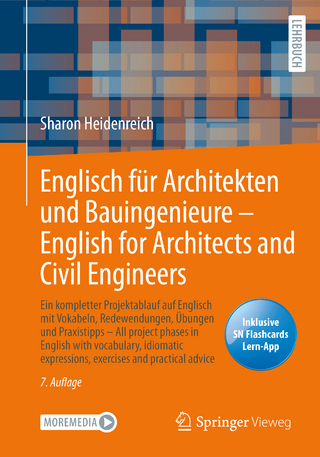
Key Issues in English for Specific Purposes in Higher Education
Springer International Publishing (Verlag)
978-3-319-70213-1 (ISBN)
Introduction.- Recent developments in ESP/EAP/EMI contexts in the world, Yasemin Kirkgöz & Kenan Dikilitas.- PART I Materials design and development in ESP.- Materials and lesson design: the beliefs and practices of experienced ESP teachers, Helen Bastürkmen & Ana Bocanegra Valle.- Innovative ESP teaching practices and materials development, Fredricka L. Stoller & Marin S. Robinson.- Using a corpus-based approach to select medical vocabulary for an ESP course: The case for high frequency vocabulary, Betsy Quero & Averil Coxhead.- Selecting Corpus-based Grammatical Structures for ESP/EAP Materials, Hossein Farhady & Kobra Tavassoli & Fariba Haghighi.- PART II ESP Teacher Development.- Lesson study: a collaborative vehicle for professional learning and practice development of ESP teachers in high education, Julie Norton.- The Process behind RA Introduction Writing among Turkish Arts and Science Scholars, Suresh Canagarajah & Demet Yayli.- Practitioner Research as a Way of Understanding my Work: Making Sense of Graduates' Language Use, Tuula Lehtonen.- Expanding Possibilities for ESP Practitioners Through Interdisciplinary Team Teaching, Tim Stewart.- Perceptions of Students, Teachers and Graduates about Civil Aviation Cabin Services ESP Program: An Exploratory Study in Turkey, Enisa Mede & Derin Atay & Nergis Koparan.- PART III Curricular Issues in ESP.- Introducing Innovation into an ESP Program: Aviation English for Cadets, Mustafa Er & Yasemin Kirkgöz.- From EFL to EMI: Hydrid practices in English as a Medium of Instruction in Japanese tertiary contexts, Naoki Fujimoto-Adamson & John Adamson.- Fostering Active Learner Involvement in ESP classes, Nemira Macianskien & lma Bijeikien .- Are We Really Teaching English for Specific Purposes, or Basic English Skills? The Cases of Turkey and Latvia, Servet Çelik, Anna Stavicka, & Indra Odina.- Listening Comprehension Strategies of EMI Students in Turkey, Adem Soruç, Asiye Dinler, Carol Griffiths.- PART IV ESP, CLIL and EMI.- ESP/EAP for University Programs outside Target Language Communities, John O'Dwyer & Hilal Atli.- The C of Cognition in CLIL Teacher Education: some insights from classroom based research, Isabel Alonso Belmonte & María Fernández Agüero.- The changing roles of EMI academics and English language specialists, Julie Dearden.- Quality Assurance of ESP Programs in the EMI Context: A case study of a private university in Turkey, Donald Staub.
"This is a well-researched and well-designed book. The authors have successfully presented a comprehensive and insightful narrative on the key trends in ESP and the related realms of EMI, CLIL, and EAP. ... The potential audience of this volume includes researchers, postgraduate and graduate students majoring in the field of applied linguistics, as well as university teachers and ESP practitioners." (Lilia Raitskaya, Journal of Language & Education, Vol. 04 (02), 2018)
“This is a well-researched and well-designed book. The authors have successfully presented a comprehensive and insightful narrative on the key trends in ESP and the related realms of EMI, CLIL, and EAP. … The potential audience of this volume includes researchers, postgraduate and graduate students majoring in the field of applied linguistics, as well as university teachers and ESP practitioners.” (Lilia Raitskaya, Journal of Language & Education, Vol. 04 (02), 2018)
| Erscheinungsdatum | 28.01.2018 |
|---|---|
| Reihe/Serie | English Language Education |
| Zusatzinfo | VI, 353 p. 24 illus. |
| Verlagsort | Cham |
| Sprache | englisch |
| Maße | 155 x 235 mm |
| Gewicht | 701 g |
| Themenwelt | Schulbuch / Wörterbuch ► Wörterbuch / Fremdsprachen |
| Geisteswissenschaften ► Sprach- / Literaturwissenschaft ► Sprachwissenschaft | |
| Sozialwissenschaften ► Pädagogik ► Erwachsenenbildung | |
| Sozialwissenschaften ► Pädagogik ► Schulpädagogik / Grundschule | |
| Schlagworte | Content-integrated language learning • English • English for specific purposes • globalization and English for Specific Purposes • learning English in Turkey • materials and lesson design for ESP • teacher development and ESP |
| ISBN-10 | 3-319-70213-0 / 3319702130 |
| ISBN-13 | 978-3-319-70213-1 / 9783319702131 |
| Zustand | Neuware |
| Haben Sie eine Frage zum Produkt? |
aus dem Bereich


